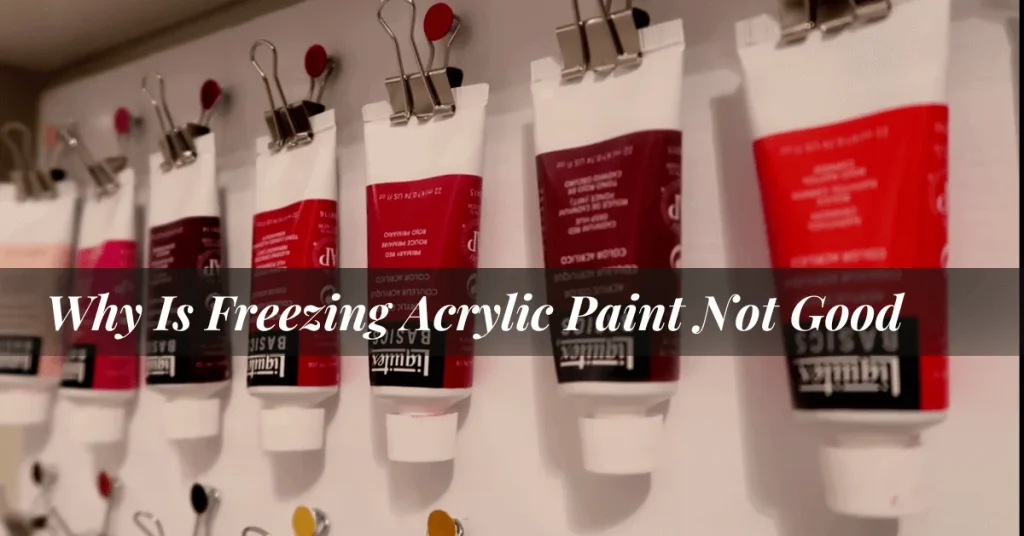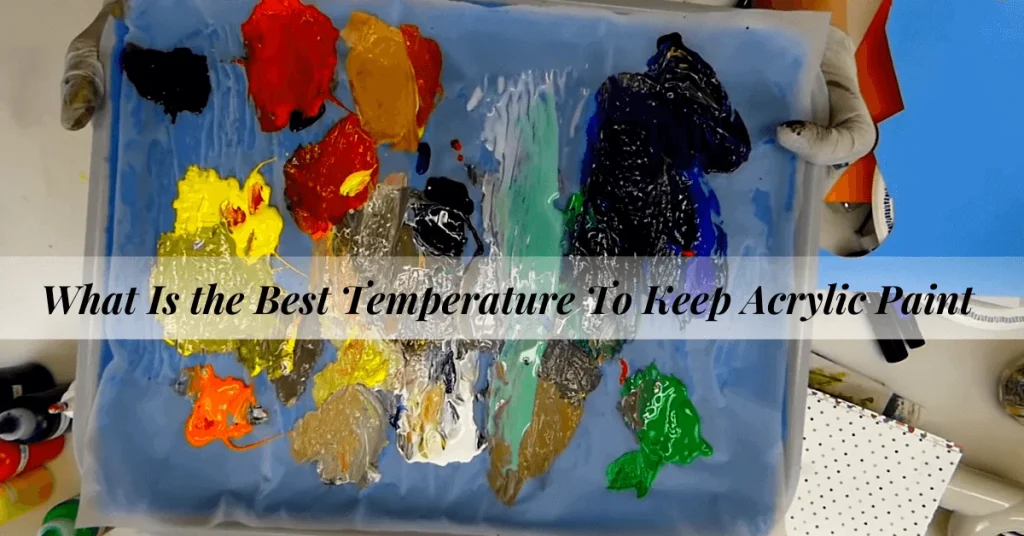Acrylic paint is water-based, consisting of polymer emulsion and pigment. The paint is quite resistant and durable and withstands fluctuating temperatures.
It survives at lower temperatures, but can you freeze acrylic paint? Well, you can freeze the paint, but it is not recommended as it can alter the consistency, quality, composition, vibrancy, and long-lasting ability of the paint during recovery (thawing).
There arises a query “What temperature can acrylic paint withstand?” Acrylic paint can withstand temperatures ranging from a low of 50 degrees Fahrenheit to a high of 360 degrees Fahrenheit. However ideal temperature to keep or store acrylic paint is 68-77 degrees Fahrenheit.
Here in Alaska, the temperature drops below 27 degrees Fahrenheit and I usually find it challenging to paint with acrylic in winter as the paint freezes most of the time. No worries, as I know how to recover the paint. Keep patience; I’ll share these strategies with you so that you’re able to recover frozen acrylic paint.
| Can You Freeze Acrylic Paint? You can freeze acrylic paint due to the water content in its composition, but the recovery becomes tough, and the quality of the dye is compromised. So better to keep the paint at room temperature (68-77 degrees Fahrenheit) to maintain its quality and lifespan. |
What Do We Mean By Freezing Acrylic Paint?
Acrylic paint has three basic ingredients in its composition which are resin, pigment, and water. It is water that freezes at low temperatures, not the other ingredients. It makes the overall paint appear frozen and hard, making it useless.
Why Is Freezing Acrylic Paint Not Good?
If you’re a logical person, you would want to know why I’m saying not to freeze your paint. Right? Well, there is a science behind it, but I’m not going to go deep into the science as both you and I are painters, not scientists. Just kidding! Here are the reasons acrylic paint should not be frozen.

- In fact, the water in acrylic paint freezes, which can separate the pigment and other ingredients, ultimately changing the consistency of the dye.
- During the thawing (melting) process, the paint doesn’t return to the original texture but loses most of its features.
- The recovered paint looks brittle, ropey, and clumpy, which is not ideal to be used for your paint job or art.
How To Store Acrylic Paint In Winters
If you’re living in a cold environment, you might be fed up with the paint getting hard and frozen frequently. I can understand you, Buddy! Apply these tricks to store acrylic paint in winter.
- Wrap your paint in a hard polythene plastic sheet.
- Select a warm location like a basement, shelf, kitchen, or any other location with a higher temperature.
- Store in a dark and moist-free spot.
- The lid of tubes or containers must be closed tightly so that no air enters the paint.
- Storing in direct sunlight is not recommended.
How To Fix Frozen Acrylic Paint? Step By Step Guide
Frozen acrylic paint can be fixed. But there are some factors you need to take into account. These include the duration of freezing and the amount of the paint that has frozen. If the entire paint is frozen and has gotten hard, it is a challenging task to recover it. Here is how to thaw acrylic paint.

Supplies Needed
- Frozen paint
- Stirrer
- Paint thinner
- Warm water
- Knife
- Bowl
Step 1: Take Out Frozen Paint
Take out the paint and put it into the bowl. Cut the tubes with a knife and remove the paint. Use a scope if the paint is in a container or a bottle for taking out the paint.
Step 2: Leave The Paint For Thawing
Now let the paint get melt or thaw at average room temperature for a few hours. If the surrounding temperature is low (in winter), wrap the bowl with a polythene plastic sheet and put it in a warm location for some hours.
Step 3: Remove Clumps
After thawing, if you notice bigger and hard clumps in the paint, better to remove these lumps. However, if the clumps are soft, they can be fixed with stirring. You can check the hardness of these chunks with a stick or your fingers.
Step 4: Add Water Or Paint Thinner
The next step is adding a small amount of water or paint thinner to the thawed paint. It will help the paint recover its consistency. You can thicken the paint later by mixing it with the same type of acrylic colour.
Step 5: Stir The Paint
Finally, stir the paint vigorously to mix it well. You can use a stick, spoon, or any hard metal tool for this purpose. Keep stirring until you get a consistent texture and all the clumps are fixed.
Congrats, you’re done!
What Is the Best Temperature To Keep Acrylic Paint?
The best temperature to keep acrylic paint is 68-77 degrees Fahrenheit. It is an average room temperature. Most paints are manufactured to work best in this range. However, these dyes are different in their response to varying temperatures.
For example, oil-based paints are different from acrylics due to the solvent. So can you freeze oil paint? Yes, oil-based paint can freeze if the temperature is dropped to -4 to -10 degrees Fahrenheit which is a very low temperature compared to 32 degrees Fahrenheit, at which acrylic paint freezes.

Can You Refrigerate Acrylic Paint?
You can refrigerate acrylic paint, but make sure you put the dye in the lower section of your fridge where the temperature is above freezing point (50 degrees Fahrenheit). Because freezing the paint can ruin its quality. However, a deep fridge is never recommended for acrylic paint.
Does Cold Ruin Acrylic Paint?
Cold is good for acrylic paint, but the freezing temperature should be avoided. It is advised to store acrylic paint in a cool place, as it helps the paint last longer but freezing damages the chemistry of the paint.
Can You Use Acrylic Paint That Has Been Frozen?
Frozen acrylic paint is not usable. There are two possibilities; the first one is when the paint is completely frozen. In this case, the dye is hard, and its fluidity is lost. Such paint can’t be fixed, or you can say very difficult to recover.
The second possibility is when the paint is partially frozen. In this case, the dye is fixable by stirring and thawing. However, the original vibrancy is not reversible once the paint is degraded by freezing.
FAQs
Can acrylic paint be left in a hot car?
Acrylic paint is left in a hot car as long as the temperature of the vehicle is not high enough to degrade the ingredients of the paint. In addition, leaving the paint for too long in a hot environment can affect its consistency. The perfect temperature for acrylic is 68-77 degrees Fahrenheit.
Does freezing paint ruin it?
Yes, freezing paint can ruin its quality because it detaches the pigment and solvent. It ultimately deteriorates the quality, texture, thickness, vibrancy, and lifespan of the paint. So you better keep it under the optimum temperature.
How do I save acrylic paint for later?
You can save acrylic paint for later by storing it under strict conditions. Always store the paint in a cool and dry spot. Close the lid tightly and put it away from direct sunlight. Protect it from moisture.
Final Words
Can you freeze acrylic paint? There might be different views, arguments, and opinions among the artists, but it is obvious to say that it is not recommended. Every brand may suggest a specific range of temperatures for their product. So never forget to read the label on the package.
I hope you find the information helpful. Kindly comment below for queries and suggestions.
Thank you!
- How To Buff Acrylic Enamel Paint In 5 Easy Steps? Thorough Guidance - February 2, 2024
- How To Make Acrylic Paint More Opaque? 10 Effective Methods - February 1, 2024
- How To Sketch On Canvas Before Acrylic Painting? Draw Like a Pro - January 31, 2024

